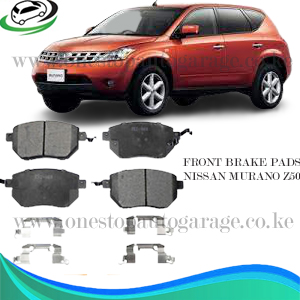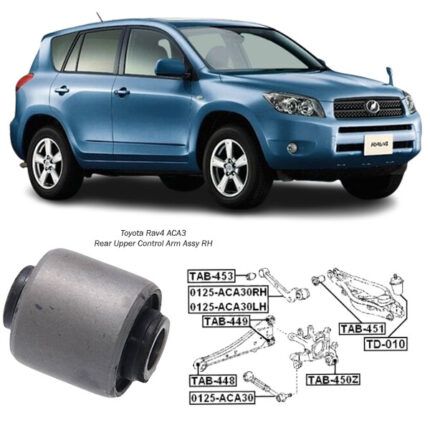-8%
Get Toyota Land Cruiser Prado 120 FJ Lower Big Arm Bush 48655-60030
The lower big arm bush, also known as the lower control arm bushing, is an essential component of a vehicle’s suspension system. It connects the control arm to the vehicle’s frame, providing a pivot point that allows the control arm to move while ensuring the wheels remain stable. A functional lower big arm bush plays a vital role in maintaining proper alignment, absorbing road shocks, and contributing to vehicle stability. In this guide, we’ll delve into the structure, function, benefits, signs of wear, maintenance practices, and replacement procedures for the lower big arm bush.
Structure and Composition of the Lower Big Arm Bush
The lower big arm bush is typically made up of three main parts:
- Metal Housing:
- The outer metal casing houses the bush and is designed to fit snugly into the control arm.
- Rubber or Polyurethane Material:
- The bushing itself is usually composed of rubber or polyurethane. Rubber bushings offer flexibility and absorb road vibrations effectively, while polyurethane bushings are firmer and last longer, though they may provide a slightly stiffer ride.
- Inner Metal Sleeve:
- The inner sleeve is where the control arm bolt passes through, providing a secure connection between the control arm and the vehicle frame.
This design allows the control arm to pivot while minimizing noise, vibration, and harshness (NVH) in the vehicle. The rubber or polyurethane material in the bushing also reduces metal-to-metal contact, prolonging the life of both the control arm and the frame.
Function of the Lower Big Arm Bush
The lower big arm bush performs multiple roles in the suspension system:
- Providing Flexibility for Control Arm Movement:
- The control arm, connected to the frame through the bush, needs flexibility to move up and down with the wheels as they traverse uneven surfaces. The bush provides this flexibility while keeping the control arm securely in place.
- Absorbing Vibrations and Noise:
- By using a flexible material like rubber or polyurethane, the lower big arm bush acts as a buffer, absorbing vibrations and road noise before they reach the passenger cabin.
- Maintaining Wheel Alignment:
- The bushing stabilizes the control arm and helps maintain correct wheel alignment, ensuring that the wheels remain perpendicular to the ground. This is crucial for consistent tire contact, which impacts handling, steering, and braking.
- Reducing Wear and Tear on Suspension Components:
- By reducing direct metal-to-metal contact, the bush minimizes wear on the control arm and frame, extending the lifespan of these parts.
Benefits of a Quality Lower Big Arm Bush
Using a high-quality lower big arm bush offers numerous advantages:
- Enhanced Vehicle Stability:
- A quality bush ensures the control arm functions properly, which stabilizes the suspension and enhances overall vehicle handling and control, especially during cornering and braking.
- Reduced Noise, Vibration, and Harshness (NVH):
- Premium bushings are effective at absorbing shocks and reducing vibration, which contributes to a smoother and quieter ride.
- Improved Tire Wear:
- By maintaining correct wheel alignment, a quality bush prevents uneven tire wear, helping to extend tire life and reduce replacement costs.
- Longer Lifespan for Suspension Components:
- A good-quality lower big arm bush minimizes wear on other suspension components, such as control arms and frame mounts, by reducing stress on these parts.
- Enhanced Ride Comfort:
- Properly functioning bushes improve ride comfort by dampening vibrations from road surfaces, making for a more enjoyable driving experience.
Signs of a Worn or Damaged Lower Big Arm Bush
Over time, the lower big arm bush is subject to wear and degradation, especially if exposed to extreme road conditions, heat, or chemicals. Here are common signs of a worn or failing bush:
- Clunking or Banging Noise:
- A failing bush may produce clunking or banging noises when driving over bumps or potholes due to excessive play in the suspension.
- Excessive Vibrations:
- Worn bushings may allow more vibrations to pass through the suspension and into the cabin, creating a less comfortable ride.
- Poor Steering and Handling:
- A loose or damaged bush can affect vehicle handling, making the steering feel loose or unresponsive, particularly when cornering or driving on uneven terrain.
- Uneven Tire Wear:
- When a bush fails, it can lead to improper wheel alignment, resulting in uneven tire wear patterns. Check your tires for any irregular wear as an indication.
- Braking Instability:
- Worn bushes can affect the control arm’s position, leading to instability during braking as the wheels may wobble or shift.
- Visible Wear and Tear:
- Upon inspection, a damaged bush may show visible cracks, splits, or deformation, especially in rubber bushings. Polyurethane bushings may crack or dry out over time.
Maintenance and Care of the Lower Big Arm Bush
Regular maintenance of the lower big arm bush is essential to ensure long-lasting performance and prevent premature wear. Here are some recommended maintenance practices:
- Regular Visual Inspection:
- Inspect the bushings for any signs of wear or damage, particularly if you hear unusual noises or feel vibrations. Cracks, tears, or excessive movement are signs the bush may need replacing.
- Lubrication for Polyurethane Bushings:
- While rubber bushings do not typically require lubrication, polyurethane bushings should be lubricated periodically to prevent squeaking and wear.
- Alignment Checks:
- Regular wheel alignment checks can help prevent undue stress on the bushings and keep suspension geometry within specifications, which prolongs the life of the bush.
- Avoid Excessive Loads:
- Overloading your vehicle can put additional strain on suspension components, including the bushings. Follow the manufacturer’s load recommendations to avoid excessive wear.
- Protection from Chemicals:
- Avoid exposure to oils, solvents, or other chemicals that may degrade rubber bushings. Polyurethane bushings are generally more resistant to chemicals but should still be protected.
Replacement of a Lower Big Arm Bush
When a lower big arm bush fails, replacement is often the best solution to restore proper suspension performance. Here is an outline of the replacement process:
- Preparation and Safety:
- Use jack stands to lift the vehicle and ensure it’s securely supported before beginning any suspension work.
- Remove the Wheel:
- Take off the wheel to access the control arm and bush assembly.
- Disconnect the Control Arm:
- Remove any bolts securing the control arm to the frame and steering knuckle to access the bush.
- Remove the Old Bushing:
- This step typically involves pressing out the old bushing with a hydraulic press. A specialized bushing removal tool may also be required.
- Install the New Bushing:
- Press the new bushing into place using a hydraulic press or bushing installation tool. Ensure the bushing is aligned correctly to avoid any fitment issues.
- Reattach the Control Arm:
- Reinstall the control arm bolts and secure the control arm to the frame and steering knuckle, tightening all bolts to the manufacturer’s specifications.
- Alignment Check:
- After replacement, have the alignment checked to ensure the suspension is correctly aligned, as replacing bushings can slightly alter alignment settings.
Conclusion
The lower big arm bush is an essential part of the suspension system, providing flexibility, stability, and noise reduction for the control arm. By understanding its structure, function, and the benefits it provides, vehicle owners can appreciate the importance of this component in maintaining a comfortable, stable, and safe ride. Recognizing symptoms of wear and following recommended maintenance practices can prolong the life of the bush and prevent costly repairs. When replacement becomes necessary, consulting a qualified mechanic is advisable to ensure the job is done accurately and safely. Properly maintained lower big arm bushes contribute significantly to vehicle performance, comfort, and overall safety on the road.
Follow us on Facebook for more parts.



